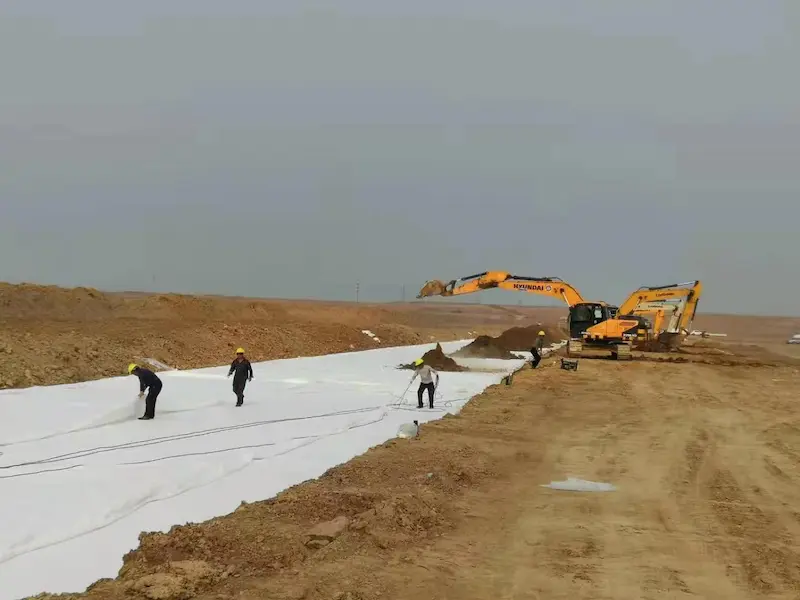Understanding the Distinction: Geotextile vs. Anti-Seepage Geotextile
Geotextiles, versatile materials designed to address various engineering challenges, play a crucial role in modern construction and environmental projects. Among the array of geotextiles available, two distinct types stand out: geotextile and anti-seepage geotextile. While both serve essential functions in civil engineering, their differences lie in their specific applications, material compositions, and the problems they address. Understanding these disparities is vital for selecting the appropriate material for specific projects.
Definition and Characteristics
Geotextiles are synthetic textile materials made from polypropylene, polyester, or polyethylene. They are engineered to exhibit specific mechanical properties, such as tensile strength, permeability, and durability. Geotextiles find extensive use in civil engineering applications, including soil stabilization, erosion control, drainage systems, and reinforcement of structures.
On the other hand, anti-seepage geotextiles, as the name suggests, are designed primarily to control water flow and prevent seepage through soil or structures. They possess superior hydraulic properties, including high water flow resistance and low permeability. Anti-seepage geotextiles are commonly employed in applications where preventing water migration is critical, such as landfill liners, reservoirs, dams, and irrigation canals.
Material Composition and Manufacturing
Geotextiles are typically manufactured using synthetic polymers like polypropylene, polyester, or polyethylene. These materials are processed through techniques such as weaving, needle punching, or heat bonding to create a fabric with specific characteristics tailored to the intended application. Geotextiles may be woven or non-woven, each offering distinct advantages in terms of strength, permeability, and filtration properties.
Anti-seepage geotextiles are engineered with an additional focus on water resistance. They are often composed of tightly woven or needle-punched fabrics with specialized coatings or laminations to enhance impermeability. These materials undergo rigorous testing to ensure they meet stringent standards for hydraulic performance, including permeability, puncture resistance, and chemical compatibility.
Applications and Functionality
Geotextiles find widespread use across various civil engineering disciplines. They are employed in soil stabilization projects to improve load-bearing capacity and reduce settlement. Geotextiles are also utilized in erosion control applications, such as slope stabilization and shoreline protection, where they help prevent soil loss due to water runoff or wave action. Additionally, geotextile fabrics are integral components of drainage systems, providing filtration and separation functions to enhance the efficiency of drainage structures.
In contrast, anti-seepage geotextiles are specifically engineered to address water containment and control challenges. They serve as critical components in the construction of impermeable barriers for containment facilities, such as landfills and ponds, where preventing the migration of contaminants is paramount. Anti-seepage geotextiles are also employed in hydraulic engineering projects to line canals, reservoirs, and irrigation channels, effectively preventing water seepage and ensuring efficient water management.
Performance and Selection Criteria
When selecting between geotextile and anti-seepage geotextile materials, engineers must consider several factors to ensure optimal performance and durability. Geotextiles intended for soil stabilization or erosion control applications require adequate tensile strength, puncture resistance, and filtration properties to withstand environmental stressors. Additionally, the permeability of the geotextile must be compatible with the hydraulic requirements of the project to facilitate proper drainage and soil consolidation.
For projects requiring water containment and seepage prevention, anti-seepage geotextiles offer superior hydraulic performance and impermeability. Engineers must evaluate the specific requirements of the project, including site conditions, water flow rates, and potential chemical exposures, to select the most suitable anti-seepage geotextile material. Factors such as puncture resistance, seam integrity, and compatibility with geomembrane liners are crucial considerations in ensuring the long-term effectiveness of anti-seepage systems.
Conclusion
Geotextiles and anti-seepage geotextiles are indispensable materials in civil engineering and environmental protection projects, offering versatile solutions to a wide range of challenges. While both types of geotextiles share fundamental characteristics, such as synthetic composition and engineered properties, their distinct focus on soil reinforcement and water containment sets them apart. Understanding the differences between geotextile and anti-seepage geotextile materials is essential for selecting the most appropriate solution to meet the unique requirements of each project, ensuring optimal performance, durability, and environmental sustainability.
About Geotextile and Anti-seepage Geotextile Manufacturer
Haoyang Environmental Co., Ltd. is established in June 2008, is a leading high-tech service provider in geosynthetic materials. Specializing in research, manufacturing, environmental consulting, and solid waste treatment, Haoyang holds ISO 9001, ISO 14001, OHSAS 18001, and CQC certifications. Recognized as Shandong Enterprise Technology Center, it boasts a proficient R&D team focusing on environmental engineering, materials, and pollution control technologies. With numerous patents and scientific accolades, Haoyang pioneers innovative solutions in environmental sustainability. Welcome to contact us.



781.webp)